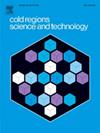Study on icing characteristics of bundled conductor of transmission line based on shadowing effect analysis
IF 3.8
2区 工程技术
Q1 ENGINEERING, CIVIL
引用次数: 0
Abstract
Icing on transmission lines significantly threatens the safety and stability of power system. Particularly for bundled conductors, the shadowing effect of the upwind conductor on the downwind one affects airflow and droplet distribution, leading to unique icing characteristics. This paper employs numerical simulations and icing tests to investigate the icing shadowing effect of bundled conductors. Firstly, the distributions of airflow and droplets around the bundled conductor are solved by the Eulerian-Eulerian two-phase flow model. Then, by solving mass and thermodynamic balance equations, the icing mass and shape accreted on the bundled conductors under various icing conditions are obtained. Further, two novel parameters, the shadowing coefficient and the offset angle, are introduced to quantify the shadowing effect's impact on ice mass and shape. The findings indicate that the ice mass ratio on the downwind conductor to the upwind conductor is influenced by wind speed, wind angle, bundle spacing, conductor diameter, and droplet parameters. In most cases, the ratio is less than 1; however, under certain wind angles, this ratio exceeds 1. The shadowing effect also impacts the ice shape on the downwind conductor, inducing an additional offset in the ice shape. The magnitude of this offset angle is also correlated with environmental parameters. Finally, the accuracy of our numerical simulations is validated by the outcomes of natural icing tests.
求助全文
约1分钟内获得全文
求助全文
来源期刊

Cold Regions Science and Technology
工程技术-地球科学综合
CiteScore
7.40
自引率
12.20%
发文量
209
审稿时长
4.9 months
期刊介绍:
Cold Regions Science and Technology is an international journal dealing with the science and technical problems of cold environments in both the polar regions and more temperate locations. It includes fundamental aspects of cryospheric sciences which have applications for cold regions problems as well as engineering topics which relate to the cryosphere.
Emphasis is given to applied science with broad coverage of the physical and mechanical aspects of ice (including glaciers and sea ice), snow and snow avalanches, ice-water systems, ice-bonded soils and permafrost.
Relevant aspects of Earth science, materials science, offshore and river ice engineering are also of primary interest. These include icing of ships and structures as well as trafficability in cold environments. Technological advances for cold regions in research, development, and engineering practice are relevant to the journal. Theoretical papers must include a detailed discussion of the potential application of the theory to address cold regions problems. The journal serves a wide range of specialists, providing a medium for interdisciplinary communication and a convenient source of reference.
 求助内容:
求助内容: 应助结果提醒方式:
应助结果提醒方式:


